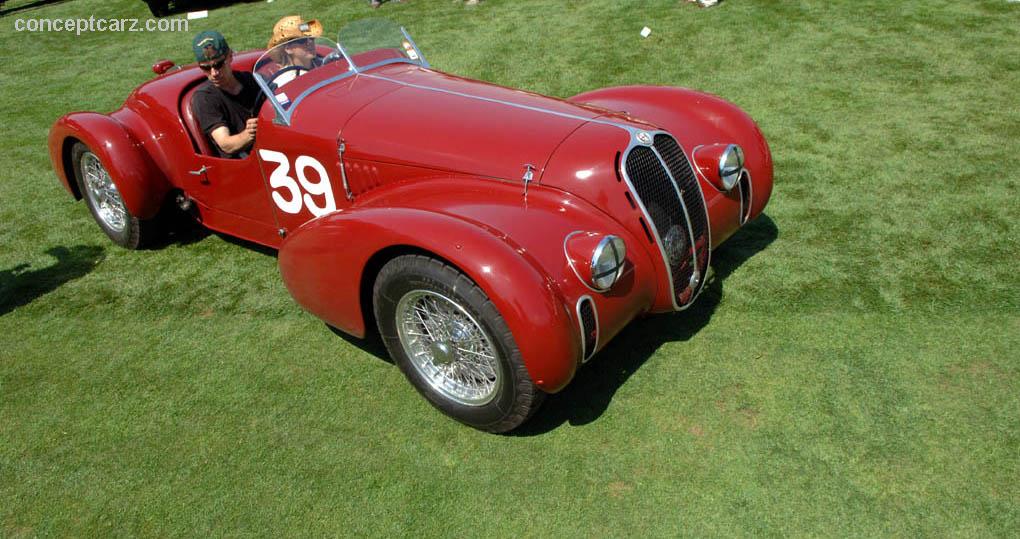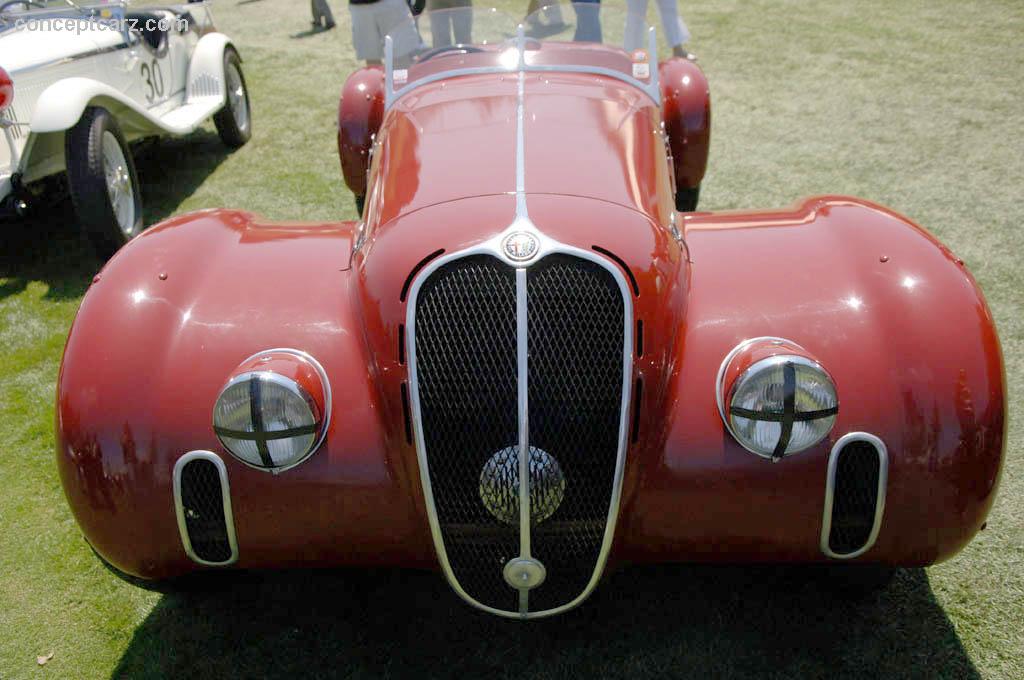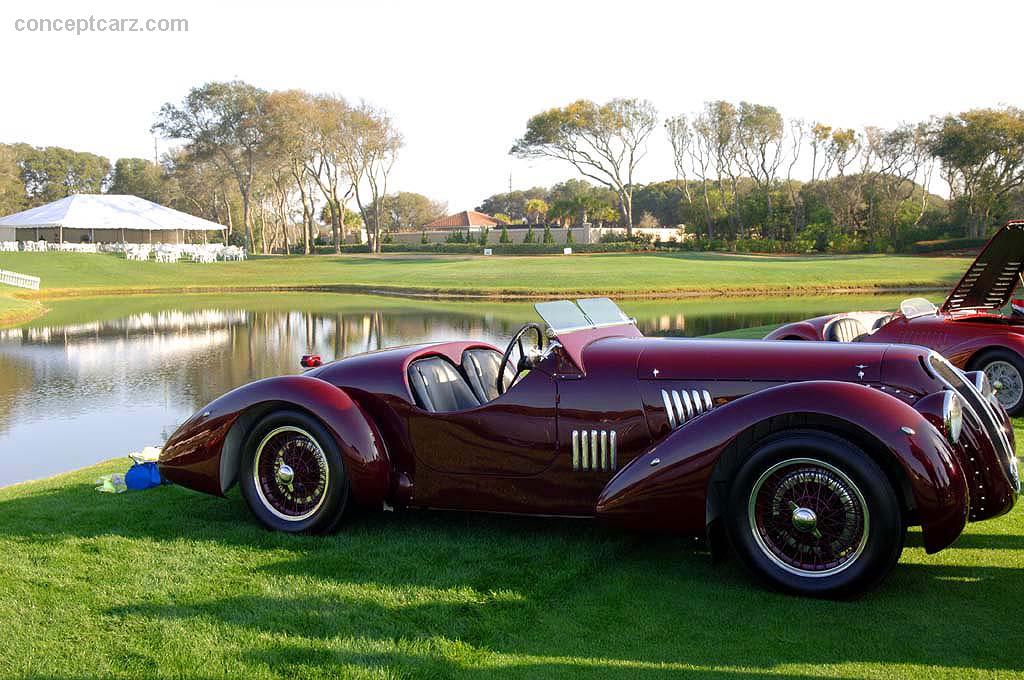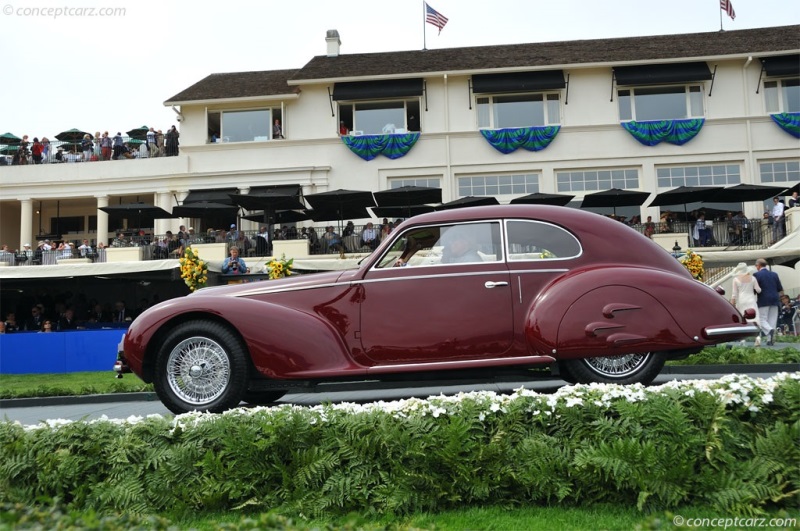What began in the mid-1920s with the 6C 1500 gradually progressed in sophistication and engine size resulting in the 6C 2500 of 1938. Introduced in 1925 at the Milan Motor Show, the Vittorio Jano-designed six-cylinder engine was based on the factory's P2 straight-8 racing engine. It was installed in a 114.2-inch wheelbase, lightweight ladder-frame chassis, and was one of the earliest Italian sports cars to incorporate Grand Prix racing technology in a production road car. Initially dubbed the Normale, it was renamed the 6C 1500 (representing its number of cylinders and its engine displacement) the following year. It was offered in three versions that included the single-overhead camshaft Normale, the twin-overhead-camshaft Sport, and the supercharged Super Sport model. Most examples received coachwork in Italy.
Roadster
Chassis #: 913213
Engine #: 923871
View info and historyThe 6C 1750 arrived in 1929 and used a 1,752cc engine. The base model used a single overhead cam, while the Super Sport and Gran Sport versions had a double overhead cam engine (DOHC). Like its predecessor, a supercharger was available. In 1929, the 6C won every major racing event in which it was entered. The final derivation of the original 6C 1500 was the 6C 1900 of 1933, which was considered a transitional model before the arrival of the 6C 2300 in 1934. Introduced that year at the Milan Salone, the engine powering the 6C 2300 had aluminum-alloy cylinder heads, a cast crankshaft, and a 2,309cc displacement. It was a lower-cost alternative to the 8C version which had been introduced in 1931. Initially, the 6C 2300 used its predecessor's chassis and technology, while the 6C 2300 B that arrived a year later was given a completely redesigned chassis with hydraulic brakes and an independent front suspension. The Alfa Romeo 6C 2500
The Alfa Romeo 6C 2500 was introduced in 1938 and was a development of the earlier Vittorio Jano-drawn 6C 2300 by Jano's successor, Bruno Trevisan. It received a larger, more powerful engine and modern coachwork and would remain in production for fourteen years, ending in 1952 when replaced by the 1900. The engine received an increase in the cylinder bore of two millimeters and an improved cylinder head for better aspiration and increased compression, from 6.5:1 to 7.1:1.
Roadster
Chassis #: 913213
Engine #: 923871
View info and historyThe Jano-designed dual overhead camshaft engine breathed through either one or three Weber carburetors, with the latter reserved for the top-of-the-range SS (Super Sport) version. The triple-carb setup offered approximately 110 brake horsepower. The steel ladder frame chassis measured 128 inches (3250mm) on the Turismo, 118.1 inches (3000mm) on the Sport, and 106.3 inches (2700mm) on the Super Sport. Most of the coachwork was created by Touring Superleggera of Milan. The four-wheel independent suspension had parallel trailing arms and coil springs in the front, and swing axles with torsion bars at the rear. Four-wheel hydraulic drum brakes resided all round.Eight examples of the 6C 2500 - known as the Tipo 256 - were prepared for the 1939 and 1940 Mille Miglia and the 24 Hours of Le Mans. The Mille Miglia was briefly stopped following an accident in 1938 that claimed the lives of a number of spectators. It resumed in April of 1940, just before Italy entered World War II, and was called the Grand Prix of Brescia. The event was held on a short course in northern Italy with drivers lapping the course nine times. An aerodynamically improved BMW 328 driven by Germans Huschke von Hanstein/Walter Baumer won the high-speed race.The 1939 24 Hours of Le Mans was held on June 17th and 18th, less than three months before the outbreak of World War II. That year, the 6C 2500SS driven by Raymond Sommer and Prince Bira failed to finish due to engine problems. The following year's 24 Hours of Le Mans was originally planned for June 1940, but due to the invasion of France in May, the race was canceled. The first 24 Hours of Le Mans in the post-war era was in 1949, four years after V-E day. 
Roadster
View info and historyThe Tipo 256 competition cars received Alfa's most powerful 120 horsepower engine built under the direction of Enzo Ferrari. This would be the final time Scuderia Ferrari ad Alfa Romeo would be working together. Both Spider and Berlinetta Touring coachwork was built.
by Daniel Vaughan | Mar 2008

Roadster
Chassis #: 913213
Engine #: 923871
View info and history
The Alfa Romeo 6C 2500 was introduced in 1938 and was a development of the earlier Vittorio Jano-drawn 6C 2300 by Jano's successor, Bruno Trevisan. It received a larger, more powerful engine and modern coachwork and would remain in production for fourteen years, ending in 1952 when replaced by the 1900. The engine received an increase in the cylinder bore of two millimeters and an improved cylinder head for better aspiration and increased compression, from 6.5:1 to 7.1:1.

Roadster
Chassis #: 913213
Engine #: 923871
View info and history

Roadster
View info and history
by Daniel Vaughan | Mar 2008
Related Reading : Alfa Romeo 6C History
The Alfa Romeo 6C 2500 was introduced near the end of the 1930s. The 6C name was derived from the engine size, an inline-six while the 2500 represented the engines cubic-centimeter displacement size. The engine was a version of Vittorio Jano designed a six-cylinder engine. The 6C was available in a plethora of body styles and wheelbases and was produced during two different times in history.....
Continue Reading >>
Continue Reading >>
Related Reading : Alfa Romeo 6C 2500 History
The engine in the 1927 Alfa Romeo 6C 1500 was the basis for a series of engines that would eventually define the marque as one of the great manufacturers of the pre-war era. The Vittorio Jano-designed engine was expanded to 1752cc and became the 6C 1750, which, in various body styles and tunes, would become the backbone of Alfa Romeo production from 1929 to 1933. Two additional cylinders were later....
Continue Reading >>
Continue Reading >>
Similar Vehicles
Similarly Sized Vehicles
from 1939
Alfa Romeo Monthly Sales Volume
March 2023
2,390
1939 Alfa Romeo 6C 2500 SS Vehicle Profiles
Recent Vehicle Additions
Related Automotive News

Phenomenal Ferraris and Italian Thoroughbreds Offered at Gooding & Company's Pebble Beach Auctions
The auction house announced a stable of Italian star cars, including a 1950 Ferrari 166 MM Berlinetta Le Mans, a 1961 Ferrari 400 Superamerica Series I Coupe Aerodinamico, and a 1954 Ferrari 500 Mondial Series I Spider.
A stunning group of star...

Ex-Scuderia Ferrari Alfa Romeo 8C 2300 Monza Spider By Zagato Scoops Best Of Show At Salon Privé
Alfa Romeo 8C 2300 Monza Spider by Zagato raced by Tazio Nuvolari wins top award
Leading designers present inaugural Churchill Cup to rare Lancia Astura
Duke of Marlborough selects his favourites on two wheels and four
Record entry for the UKs...

Make Lancia Great Again: London Concours Reveals Lancia Legends Display
The London Concours has announced its Lancia Legends display – a celebration of cars from the golden era of Lancia
Line-up includes icons like Henri Toivonens Lancia 037 Rally Evo 2, a one-of-59 B24 Spider and the ultimate Flaminia a Super Sport...

Jay Kay's Cosmic Girls Lead Star Cars At Bonhams Bond Street Sale
Trio of Rare Supercars Offered from Jamiroquai Singers Collection
Jay Kay with his (L-R) 2016 Ferrari F12tdf Berlinetta,
1973 Porsche 911 Carrera RS 2.7-litre Lightweight and 2004 Porsche Carrera GT
A trio of rare and coveted motor cars...

1938 Alfa Romeo 8C 2900B Touring Spyder Epitomizes The Elegance at Hershey
HERSHEY, PA - The theme for this years Elegance at Hershey is Celebration of Speed. After deciding upon the overall theme, One of the first decisions we made was to choose an automobile that epitomized that concept, stated Steve Moskowitz,...



































